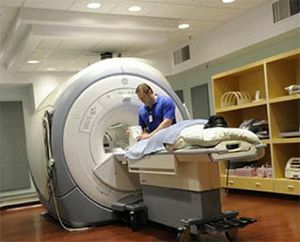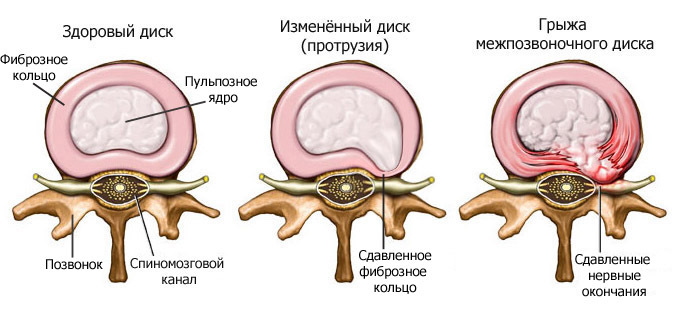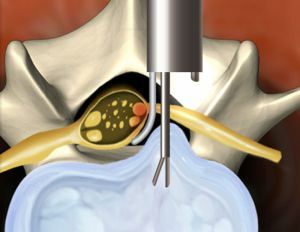 Spine - a kind of constructor, built of 33 vertebrae - small bony formations.
Spine - a kind of constructor, built of 33 vertebrae - small bony formations.
All vertebrae consist of the vertebral body itself and the arc that is attached to it from behind.
Each element of the spine is connected to its "neighbor" by the intervertebral disc.
Article Contents
- Anatomical digression
- Indications
- operation Preparation for intervention
- stroke operation
- Microdiscectomy the lumbar
- the cervical spine
- Rehabilitation after surgery
- Restrictions after surgery
- Complications
- cost of the procedure they went through
procedure Anatomical digression
intervertebral disc - cartilaginouseducation, which acts as a connective tissue between the vertebrae. It also performs the functions of depreciation with the movement of the spine, ensures its elasticity and flexibility.
The intervertebral disc consists of several layers:
- gelatinous or pulpous nucleus - has a soft consistency;
- fibrous ring is a denser connective tissue with high strength, surrounding the pulpous core.
The lack of treatment of the intervertebral hernia, especially its neglected forms, can lead to serious illness and disability.
The most gentle and easy for the patient method of eliminating this disease is microdiskectomy - a microinvasive operation to remove the intervertebral hernia and eliminate pressure on the spinal nerve or spinal cord.
The operation is performed with the mandatory use of microsurgical instruments, as well as an operating microscope. At the same time, bone tissues are not affected, and there are practically no traces left from the incision.
Positive moments of the operation include its transience( 10-30 minutes), and the short duration of stay in a hospital: 2-4 days, and possibly even less.

Indications for operation
Microdiscectomy is most often performed in the lumbar or cervical spine.
The lumbar department operates in the case when the hernia is large or conservative treatment has not yielded results.
This is necessary to eliminate pains in the lower limbs( sciatica) arising from the squeezing of the nerve root, as well as to prevent paralysis, which can occur due to pressure on the spinal cord.
It is not uncommon for cases of disruption in the functioning of the bladder and / or intestines due to the effect of hernia on nerve bundles. In this case, microdiscectomy is also shown.
In the cervical spine, the operation is also performed in order to remove the pain that has appeared due to the influence of the hernia, hypertrophied ligaments or bone processes on the spinal cord and nerve roots.
Because of the anatomical features of the spine in the neck, along with microdiscectomy, a stabilizing operation can be performed to stop the friction between the vertebrae that connect to the affected disc, as well as restore the original distance between them.
General indications:
- inefficiency of conservative( medical, physiotherapeutic) treatment for 6 weeks;
- cauda equina syndrome or paralysis;
- severe pain syndrome;
- , the presence of a hernia from an MRI or CT scan.
 Congenital disease, which appears in cases of intrauterine growth disorders of the fetus, Sprengel's disease is a danger nearby.
Congenital disease, which appears in cases of intrauterine growth disorders of the fetus, Sprengel's disease is a danger nearby. Why is it important to identify the plantar fasciitis in time and what symptoms indicate the onset of the disease. Methods of therapy and prevention.
Preparing for intervention
Preparing the patient for surgery is as follows:
- examination with a doctor;
- conducting magnetic resonance imaging or computed tomography;
- fasting before surgery for 8 hours;
- examining the anesthesiologist and selecting the optimal method of anesthesia based on the data on allergic reactions to the drugs, as well as the patient's medical history.
In order to give the anesthesiologist the most detailed picture of chronic diseases and especially allergic reactions, it is best to prepare and collect all the information in advance.
Progress of operation
Depending on the spine, the procedure is different.
Microdiscectomy of the lumbar region
An incision of 2-4 cm is made first in the area of the affected disc. Then, with the help of special tools, the side of the muscle is moved to the 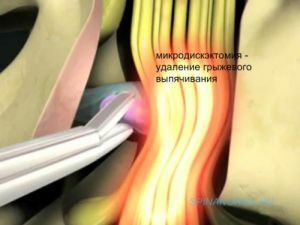 and the yellow membrane that covers the nerve roots is removed.
and the yellow membrane that covers the nerve roots is removed.
For an in-depth review of neural beams, an operating microscope is used.
After all the "obstacles" are pushed aside, the intervertebral disc tissue is removed from under the nerve roots.
Further, the laser irradiation of the disk is necessary, which is necessary to accelerate the recovery processes, as well as to avoid relapse. The completion of the operation is suturing the surgical incision.
Neck section
Incision is made on the front surface of the neck. All the muscles and organs that prevent access to the vertebrae are also pushed aside without cuts and lesions.
Next, the hernia, the affected disc, is removed. However, this operation ends in very rare cases. Most often, after the removal of damaged tissues, the spine stabilizes, which consists in "replacing" the removed cartilage with a prosthesis or with the patient's own bone tissue.
After stabilization, the cut is also sewn.
Rehabilitation after operation
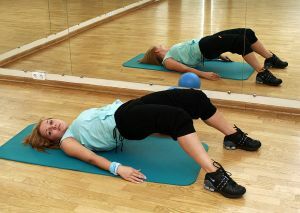 After the patient has left anesthesia, it is recommended that he immediately get up and walk a little.
After the patient has left anesthesia, it is recommended that he immediately get up and walk a little.
This is necessary for the spine to "stand in place", as well as to give it( the spine) flexibility and prevent the formation of tissue scars at the site of the operation.
After the operation in the lumbar department, it is recommended to wear a semi-rigid corset for 1-2 months, a cervical head rest on the cervical part.
You can start non-physical activity after 1-2 weeks, to physical - in 3-4 weeks.
Restrictions after operation
During rehabilitation after microdiscectomy, it is prohibited to sit too long, make sharp slopes, twist your body, stretch, lift weights( more than 3 kg).Some specialists forbid sitting up to 6 weeks after the operation.
Complications of
Microdiscectomy and postoperative complications are infrequent, but there are:
- Gap rupture of the cerebrospinal fluid, resulting in leakage of cerebrospinal fluid. In this case, the patient must comply with bed rest for tissue healing.
- Incontinence of urine or feces.
- Nerve root damage.
- Infection.
- Bleeding.
- Inflammation of the disc.
The probability of recurrence of the disease in the first year after the operation is 5-10%.
Cost of procedure
In the capital, the cost of microdiscectomy is 60-80 thousand rubles depending on the prestige of the institution and the additional services provided by 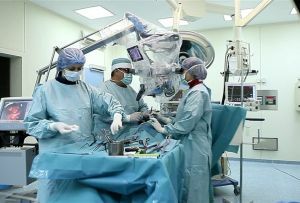 .
.
The specified price range usually includes a pre-operative examination with the necessary analyzes, the operation itself and monitoring in the hospital( if it is supposed to) in the post-operation period.
In other cities prices are slightly lower:
- Petersburg - 45-60 thousand rubles;
- Krasnodar - 30-35 thousand rubles;
- Novosibirsk - 35-40 thousand rubles;
- Yekaterinburg - 30-35 thousand rubles.
The prices shown are justin binding. The specific cost of the operation is determined in each case separately.
They went through the procedure
The comments of patients who had microdiscectomy made it possible to conclude that after the operation they all felt relief and reduced pain in the spine.
Did this operation, because there was no other way out - a 9 mm hernia in the lumbar region led to paralysis of the foot. After the operation, the pain immediately stopped and this is a huge plus.
However, I believe that surgical intervention is an extreme case. And the price bites.
Anna, 25 years old
She was suffering from hernia for 6 years, tried everything: massages, manual therapy, medical treatment. The result was, but after a while everything returned, and sometimes it got worse than before. Then I decided on an operation. The pain disappeared instantly. Restored the usual rhythm of life for about six months. Now I try to avoid excessive stress and do special exercises for the spine.
Olga, 31 year old
For a long time, pains in the lower back pain with recoil in the leg and her numbness. Regularly went to the hospital for a course of injections and droppers, but the result was not too impressive.
The doctor advised microdiscectomy and I agreed. After the operation, it turned out that I had already forgotten how to live without pain.
Pleased care and attention in the hospital.
Alexander, 40 years old
 According to statistics: every 10th patient suffering from a herniated intervertebral disc needs surgery. Naturally, it is possible to alleviate or even cure this disease in its early stages with the help of a conservative method, however, it takes a lot of time and patience.
According to statistics: every 10th patient suffering from a herniated intervertebral disc needs surgery. Naturally, it is possible to alleviate or even cure this disease in its early stages with the help of a conservative method, however, it takes a lot of time and patience.
Therefore, those who can not wait so long, agree to surgery.
And the most effective and safe operation for the removal of the intervertebral hernia is microdiscectomy.

